Aerial Photography
WWI saw the emergence of aerial photography as a useful tool to determine troop locations, trenches, ammo storage areas, etc. Although crude, with the photographer hanging over the side of his aircraft, it gave the side with the best photo coverage an advantage in determining their offensive attack plans. WWII saw the need for more sophisticated methods of obtaining photographic coverage. We needed photos of areas to be bombed, airfields, dams, bridges, etc. A most important usage was bomb damage assessment. Bomber Command needed to know the results of bombing raids. Probably our best effort was to modify 118 B-29s to a F-13.
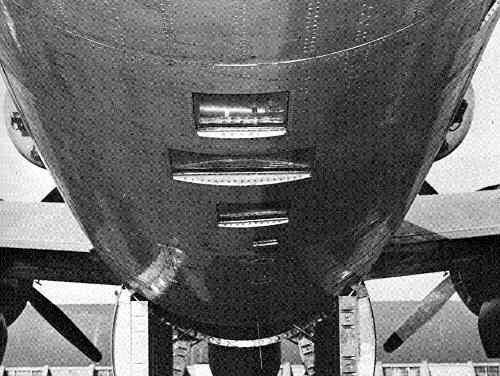
F-13 - ¾ inch glass photo windows in RB-29
Photo ctsy USAF
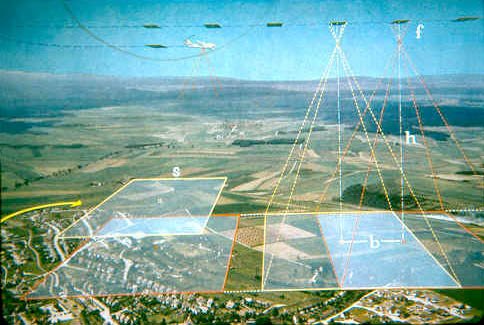
Flight plan - Exposure stations of mapping aircraft
Photo ctsy W. Mayo
Since the B-29 was pressurized it was necessary for ¾ inch thick glass windows to be installed by Continentals Denver Modification Center. Fitting these windows involved considerable structural work on the airframe. The typical F-13 carried many cameras for high altitude work. The tri-metrogon set up consisted of three cameras, one pointing straight down, and one on each side mounted at an angle to give horizon to horizon coverage. Total coverage of the three cameras was 194 degrees, 7 degrees above each horizon. These were K-17 cameras with between the lens shutters, with a six inch focal length. Resolving power of these cameras was not very good when compared with the lenses of today. The next setup was called the split vertical. The camera mount contained two K-22 cameras with 40 inch focal length. These cameras had focal plane shutters and were mounted side by side to give side lapping coverage. The next setup had an arrangement to install a variety of mounts which could hold a variety of cameras. The K-18 could be used which produced a 9 X 18 inch negative. The K-19 night camera could be installed here with the photoelectric cell. Most of the time a K-17 with a 12 inch FL was used which could be corrected for tip, tilt, and swing. A viewfinder allowed the photographer to determine overlap, and crab. An intervalometer for each camera allowed setting the trip timing to give 60 percent overlap. One special RB-29 had a 100 inch focal length camera mounted in the bomb bay shooting out a side window. The F-13 was built specifically for surveillance and reconnaissance.
Photographic Enlargers
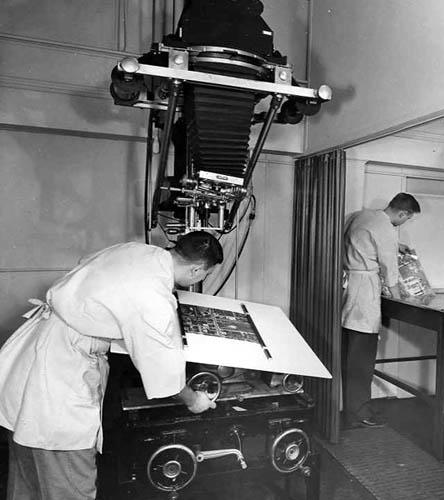
Saltzman photographic enlarger
Photo by W. Mayo enlarge photo
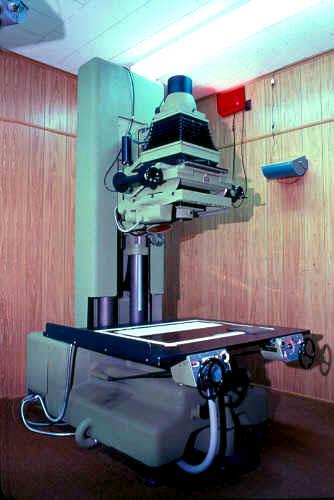
Wild E-4 rectifying enlarger
Photo by W. Mayo enlarge photo
The aerial negative could be placed in a photographic enlarger and could produce an image of various enlargement ratios. We will follow the simple procedures to the final sophisticated computerized capability. Accurate measurements cannot be made on a photo enlargement as it is a perspective projection. Enlargers were improved to allow for correction of a negative that at the time of exposure had tip or tilt. Next came the so called rectifying enlarger. The film plane and easel could be tilted but the projected result was still a perspective projection, not useable for measurements. Next came a great improvement when Wild-Heerbrug introduced the E-4. This system solved the Scheimpflug condition electronically, which must be adhered to if the image plane is tilted with respect to the object plane when projecting images through a lens. The Scheimpflug condition states that if a line is drawn through the image plane, the object plane, and the lens plane, then all three lines will intersect at the same point in space. This is so far the best rectification system available. To my knowledge there is only one in use in the U.S.
If the image and object planes are parallel, then the lens plane must also be parallel. If the ground is perfectly flat, then the E-4 enlarger can produce a rectified enlargement from which one could obtain fairly accurate measurements. After all this, it is still a perspective projection, and we must solve the problem of relief in the terrain which will cause scale change. Simple put, you cannot take a measurement on any perspective enlargement that has the normal variation of ground relief. The enlargement will contain various scales as the ground elevation varies. Scale is the ratio of a distance on a photograph or map to it's corresponding distance on the ground. So, regardless of the sophistication of the rectifying enlarger it still produces a perspective projection. To be able to take measurements we must have an orthographic projection!
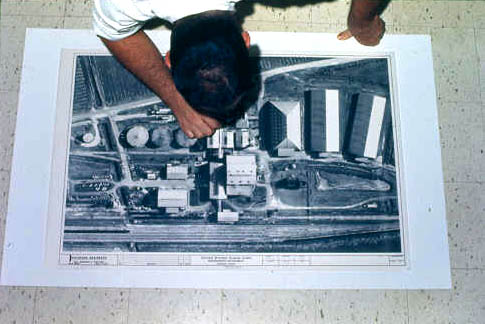
Examining a mylar sheet produced on a photographic enlarger
Photo by W. Mayo enlarge photo
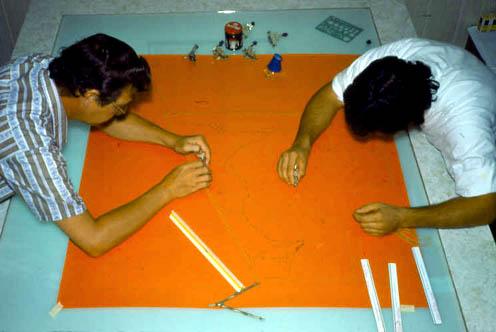
Hand scribing, an outmoded method replaced by automatic procedures
Photo by W. Mayo enlarge photo


